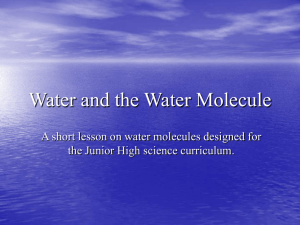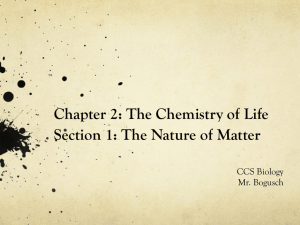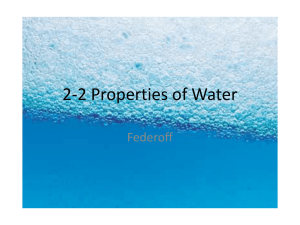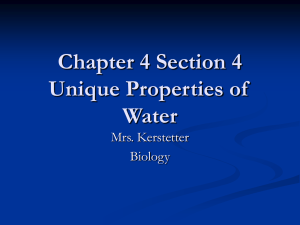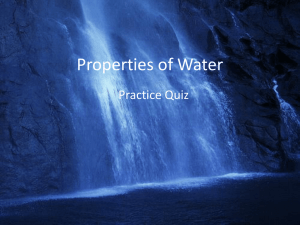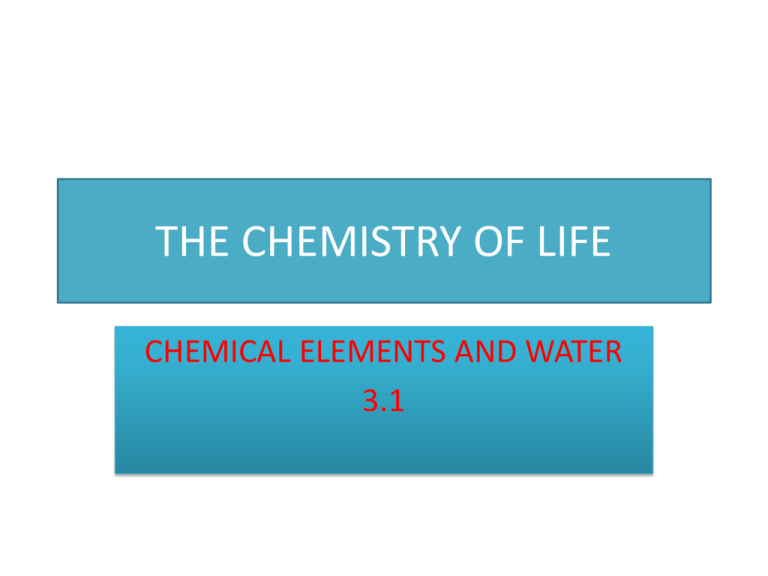
THE CHEMISTRY OF LIFE
CHEMICAL ELEMENTS AND WATER
3.1
3.1.1 State that most frequently occurring chemical elements in
living things are carbon, hydrogen, oxygen, and nitrogen
• Elements are the basic units of pure substances
• An atom is the smallest part of an element that can
take part in a chemical change.
• At the centre of an atom is a nucleus of protons
(positively charged particles), and usually also neutrons
(uncharged particles). Around the nucleus are tiny
particles called electrons (negatively charged).
• A molecule is a group of like or different atoms held
together by chemical forces.
• A compound contains two or more elements
chemically combined together.
• If an atom gains or loses an electron an ion is formed.
Chemical elements
• Life requires about 25 elements. Four of these –
Oxygen (O), Carbon ( C), Hydrogen (H), and
Nitrogen (N)- make up about 96% of human
body, as well as most other living organisms.
• These four elements are the main ingredients of
biological molecules such as proteins, sugars and
fats.
• Why do these four elements predominate in
living things?
•
• The elements carbon, hydrogen, and oxygen
predominate because living things contain large
quantities of water, and also because most other
molecules present in cells and organisms are
compounds of carbon combined with hydrogen
and oxygen, including the carbohydrates and
lipids.
• The element nitrogen is combined with carbon,
hydrogen, and oxygen in compounds called
amino acids from which proteins are constructed.
Human body
•
•
•
•
•
•
Hydrogen
Oxygen
Carbon
Nitrogen
Calcium
Phosphorus
-63%
-25.5%
-9.5%
-1.4%
-0.31%
-0.22%
3.1.2 State that a variety of other elements are needed by living
organisms, including sulfur, calcium, phosphorus, iron and sodium
• Sodium (Na), potassium(K), calcium (Ca),
phosphorus (P), sulfur (S), chlorine (Cl), and
Magnesium (Mg) account for the remaining
4% of the human body. These elements are
involved in such important functions such as
bone formation, nerve signaling and DNA
synthesis.
3.1.3 State one role for each of the element mentioned in 3.1.2
• Needed to make 2 of the 20 amino acids that proteins
contain. Found in protein molecules
Role in Prokaryotes
• Some prokaryotes use a chemical reaction involving
sulfur as their source of energy (chemo-autotrophs)
Role in Plants and animals
• Plant and animals require sulfur to produce some of
the amino acids that are part of enzymes they need
• In some Vitamins
Calcium
• Important for healthy bones and teeth; helps
muscles relax and contract; important in nerve
functioning, blood clotting, blood pressure
regulation, immune system health. Regulates
processes inside the cell including transcription.
Role in Prokaryotes
Involved in maintaining the cell structure and
movement
Co-factor for certain enzymes
Contributes to heat resistance of bacterial
endospores
Calcium
Role in Plants
Component of cell walls and cell membranes
Co-factor for certain enzymes
Role in animals
Constituent of bones
Muscle contraction
Blood clotting
Co-factor for certain enzymes
Phosphorus
• Part of the phosphate group in ATP and DNA
molecules. Important for healthy bones and teeth;
found in every cell; part of the system that maintains
acid-base balance
• Role in Prokaryotes
• Synthesis of nucleotides, ATP
• Role in plants
• Synthesis of nucleotides, ATP
• Role in animals
• Synthesis of nucleotides, ATP, constituent of bones
Iron
• Iron is needed to make hemoglobin in many
animals. Vital for energy processing and
transporting oxygen in your blood.
Role in Prokaryotes
• Constituent of electron transport molecules
• Chlorophyll synthesis in photosynthetic
prokaryotes
Role of iron in plants and animals
• In plants
• Constituent of electron transport molecules
(e.g. cytochromes)
• Chlorophyll synthesis
• In animals
• Constituent of electron transport molecules
• (e.g cytochromes and haem part of
hemoglobin)
Sodium
• Needed for proper fluid balance, nerve
transmission, and muscle contraction.
Pumped into the cytoplasm to raise solute
concentration and cause water to enter by
osmosis.
• Role in Prokaryotes
• Involved with potassium in membrane
function
• Indirectly helps move the flagellum
-• Role in plants
• Involved with potassium in membrane function
• In some plants (C4 plants) sodium can help bind
carbon dioxide for photosynthesis
• Role in animals
• Membrane function along with potassium.
• nerve impulse transport.
• Aids glucose transport across membranes
Trace elements (less than 0.01%) : Boron, chromium, cobalt,
copper, fluorine, iodine, iron, manganese, molybdenum,
selenium, silicon, vanadium and zinc.
• Iodine - Essential element of thyroxine hormone
• Manganese-Mn is an antioxidant, activates
numerous enzymes and has roles in protein,
carbohydrate and fat metabolism. It is necessary
for blood sugar regulation, healthy nerves and
brain, sex hormone production, normal skeletal
development, production of mother's milk and a
healthy immune system.
• Magnesium- in chlorophyll- in green plants and
certain prokaryotes.
For all the elements mentioned above make a table with the names of
elements and their functions in plants, animals and prokaryotes.
3.1.4 Draw and label a diagram showing the structure of water
molecules to show their polarity and hydrogen bond formation
Structure of water molecule
• Water molecules consist of two hydrogen atoms
bonded to an oxygen atom. The hydrogen atoms
have slight positive charge and the oxygen atom has a
slight negative charge. So water molecules have two
poles- a positive hydrogen pole and a negative oxygen
pole. This feature of a molecule is called polarity.
• Covalent bonds (sharing of electrons) keeps the
atoms together.
• The structure of water molecule is fixed: the small
hydrogen atoms bond to the larger oxygen atom at a
fixed angle as shown in the figure.
-• Positive and negative charges attract, there will
be an attraction force (hydrogen bond) between
the (slightly positive) hydrogen of one water
molecule and the (slightly negative) oxygen of
the adjacent molecule.
• Due to the water molecule having a slightly
positive and a negative side we can say it has
two poles: a positive and a negative pole.
• That means water is polar and polar solutes are
likely to dissolve in t, whereas non-polar
molecules will not.
Hydrogen bonding in water is a result of
polarity.
• Hydrogen bonds are not complete chemical
bonds. There is no sharing or transferring of
electrons. Instead, it is an attraction force
between a slightly positive hydrogen atom and
a slightly negative oxygen atom.
Hydrogen bonds are much weaker than
covalent or ionic bonds. They are
significant and are quite common. A lot of
hydrogen bonds together are strong. For
example the bonds between
complementary bases keep the two
strands of DNA double helix together .
Hydrogen bonds in DNA
Hydrogen bonds
attract water
molecules to charged
particles or charged
surface.
Refer to the water molecule and the hydrogen bond it forms from IB By C.J. Clegg
page number 39
--•
•
•
The hydrogen and oxygen atoms in a single water molecule are held together by
a type of bond called a polar covalent bond. Polar covalent bond results from
unequal sharing of electrons. In water, the single oxygen atom is bonded to two
different hydrogen atoms. Each oxygen-hydrogen bond is a polar covalent bond
and results in slight negative charge at the oxygen end of the molecule and a
slight positive charge at the end with the two hydrogen atoms.
(In molecules of one element like oxygen and hydrogen, the two identical atoms
exert an equal pull on the electrons. The covalent bonds in such molecules are
said to be non polar because the electrons are shared equally between the
atoms.
Water is composed of atoms with very different electronegativity. Oxygen is one
of the most electronegative of the elements. Oxygen attracts the shared
electrons in water much more strongly than does hydrogen, so that the shared
electrons spend more time near the oxygen atom than near the hydrogen atoms.
This unequal sharing of electrons produces what is called polar covalent bond)
• A bond can form between the positive pole of one water
molecule and the negative pole of another. This is called a
hydrogen bond. In liquid water many of these bonds form,
giving water properties that make it very useful substance
for living organisms. The diagram above shows hydrogen
bond between two water molecules.
3.1.5 outline the thermal, cohesive and solvent properties of
water
• Thermal Properties
• Water has a large heat capacity- large amounts
of energy are needed to raise its temperature.
The energy is needed to break some of the
hydrogen bonds.
• Water has a better ability to resist temperature
change than most other substances. Because of
this property Earth’s giant water supply
moderates temperatures, keeping them within
limits that permits life.
Thermal Properties
• High specific heat
• Water requires a lot of energy to warm up and gives off a lot of
energy when cooled down.
• Transport
• Blood can carry heat to colder places in our body, your nose goes
red when you are skiing or skating
• High heat of vaporization
• Water requires a lot of energy to change from a liquid into a gas
due to cohesion.
• Coolant
• Both plants and animals evaporate water which has a cooling
effect- a little will take up a lot of energy to evaporate
Heat energy and the temperature of
water
• A lot of heat energy is required to raise the
temperature of water. This is because much energy is
needed to break the hydrogen bonds that restrict the
movements of water molecules. This property of water
is its specific heat capacity. The specific heat capacity
of water is the highest of any known substance.
• As a result aquatic environments like streams and
rivers, ponds, lakes and seas are very slow to change
temperature when the surrounding air temperature
changes.
• Aquatic environments have much more stable
temperatures than terrestrial environments do.
Latent heat of vaporisation
• The hydrogen bonds between water molecules make it
difficult for them to be separated and vaporised. This
means that much energy is needed to turn liquid water
into water vapor (gas). This amount of energy is the
latent heat of vaporisation, and for water it is very
high.
• As a result, the evaporation of water in sweat on the
skin, or in transpiration from green leaves, causes
marked cooling. The escaping molecules take a lot of
energy with them. You experience this when you stand
under a fan after vigorous exercise.
Latent heat of Fusion
• The amount of heat energy that must be
removed from water to turn it to ice is very
great, as is that needed to melt ice. This
amount of energy is the latent heat of fusion,
and is very high for water.
• As a result, both the contents of cells and the
water in the environment are always slow to
freeze in extreme cold.
The density of ice
• Water reaches it maximum density at 4 ̊C. So
as water freezes, the ice formed is less dense
than the cold water around it. As a result, ice
floats on tope of very cold water. The floating
layer of ice insulates the water below. The
consequence is that lakes rarely freeze solid;
aquatic life can generally survive a freeze-up.
Cohesive Properties of water
• Water molecules are highly cohesive. Cohesion is
when molecules of the same type are attracted to
each other. This attraction is due to the polar
covalent bonding. Whenever two water
molecules are near each other the positive end of
one attracts the negative end of another.
• When water cools below the freezing point,
molecular motion has slowed to the point where
these polar attractions become locked into place
and an ice crystal forms.
Surface Tension
• Hydrogen bonds give water unusually high surface tension,
making it as though it were coated with an invisible film. The
insect called a water spider, takes advantage of the high
surface tension of water. It strides across ponds without
breaking the surface.
Solvent Properties
• Water is polar and will dissolve many polar
solutes and this property helps the xylem in
plants to transport water and minerals
• Phloem to transport water and sugar
• Animals to transport oxygen, glucose, urea
through blood
• Reactions involving polar molecules can take
place in water as water is the medium for all
metabolic reactions
Some common aqueous solutions in which specific biochemical
reactions take place
• Cytoplasm – glycolysis/protein synthesis
• Nucleoplasm – DNA Replication/transcription
• Stroma – light-independent reaction of
photosynthesis
Blood plasma – loading and unloading of gases
3.1.6 Explain the relationship between the properties of water and
its uses in living organisms as a coolant, medium for metabolic
reactions and transport medium
• A large body of water can store a large amount of
heat from the sun during warm periods. At cooler
times, heat given off from the gradually cooling water
can warm the air. That’s why coastal areas have
milder climates than inland regions.
• Water’s resistance to temperature change also
stabilizes ocean temperatures, creating a favorable
environment for marine life.
• Blood, which is mainly composed of water, can carry
heat from warmer parts of the body to cooler parts.
Blood is used as a transport medium for heat
• The boiling point of water is high, because to change it
from liquid to gas all of the hydrogen bonds between the
water molecules have to be broken.
• Water is below boiling point almost everywhere on Earth,
and in most areas it is above freezing point. As a liquid,
rather than a solid or a gas it can act as the medium for
metabolic activities.
• Another way water moderates temperatures is by
evaporative cooling. When a substance evaporates, the
surface of the liquid remaining behind cools down as the
molecules with the greatest energy leave. Evaporative
cooling helps prevent land-dwelling organisms from
overheating.
• Evaporation from a plant’s leaves keeps them from
becoming too warm in the sun, just as sweating helps
to dissipate our excess body heat.
• The evaporation of surface waters cools tropical seas.
• Solvent properties:
• Many different substances dissolve in water because
of its polarity. Inorganic particles with positive or
negative charges dissolve, for example sodium ions.
Organic substances with polar molecules dissolve, for
example glucose. Enzymes also dissolve in water,
-• Most chemical reactions in living organisms take place with all of
the substances involved in the reactions dissolved in water. Water
is the medium for metabolic reactions.
• The solvent properties of water allow many substances to be
carried dissolved in water in the blood of animals and the sap of
plants. Water can be used as transport medium.
• Xylem carries water and dissolved minerals up from the root
system to the leaves of a plant. Phloem then transports dissolved
sugars from the leaves to the stems, roots and flowers of a plant.
• Blood is the common transport medium in animals and is largely
made up of water.
•
• Tree depend on cohesion to help transport
water and nutrients from their roots to their
leaves. (water is used as a transport medium in
the xylem of plants)
• The evaporation of water from leaves exerts a
pulling force on water within the veins of a leaf.
Because of cohesion, the force is relayed
through the veins all the way down to the roots.
As a result water raises against the force of
gravity.
Reference
• Made use of IB Biology By Alan Damon,
Minca, C. J. Clegg




